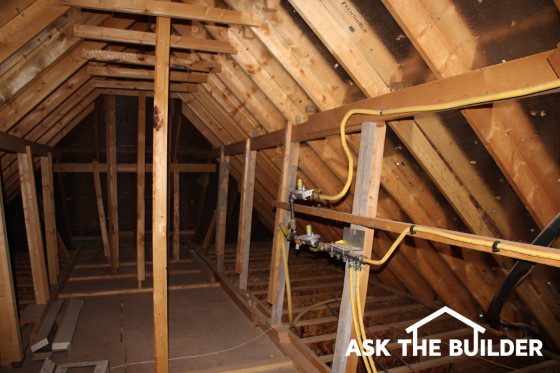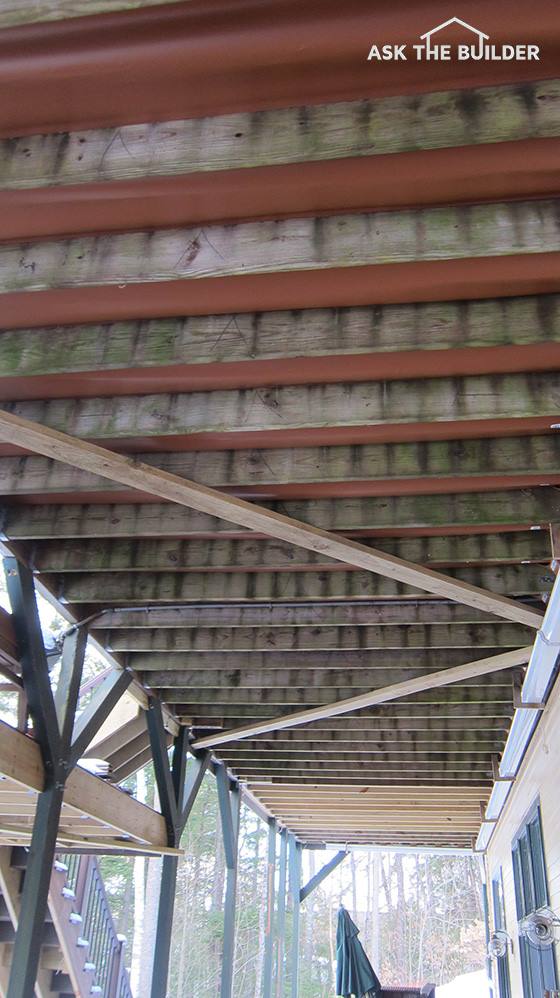Roof Popping Noise
Roof Popping Noise TIPS
- Roof popping in the wind is flexing the rafters or trusses
- Popping in the morning and evening is thermal expansion
- Diagonal braces almost always stop the noise
- Residential structural engineer is the pro to get for a consult
- CLICK HERE to Get Tim's FREE & FUNNY Newsletter!
DEAR TIM: I need your opinion about my roof. I’m afraid it’s going to collapse because when the wind blows it makes a scary popping noise.
When the wind gusts, it actually sounds like the roof could rip off the house. I’ve also noticed similar noises on calm days in the morning and later in the day after the sun goes down.
Should I be concerned? Is there someone I can call to get a professional opinion so I can sleep on windy nights? Billie A. Lawton, OK
DEAR BILLIE: I believe that I can give you some comfort right away.
Roof Framing Needs To Be Substantial
Based on the photos you sent, it appears your roof framing is quite substantial. The only way for me to have full confidence would be for me to be in your attic and inspect all the locations where one piece of lumber is connected to another.
Fortunately, it appears it’s pretty easy to get around up in your attic because it’s a steeper roof and it was common framed instead of using prefabricated trusses.

This roof framing looks normal but it makes noise when the wind blows. ©2017 Tim Carter
Common Complaint
Your complaint is fairly common and it reminds me of a house I looked at here in New Hampshire not too long ago. The wife complained about the same issues you’re having but the popping noises happened each sunny day in the morning. All would then be quiet until after the sun went down.
Wind Pressure Enormous
The wind pressure against a roof, or entire home, can be enormous. You can demonstrate this to yourself quite easily by trying to carry something large and flat on a windy day. Years ago as a young builder, I almost got blown off a roof while trying to carry a sheet of 4 x 8 plywood. A sudden wind gust knocked me down and the plywood sheet went sailing out of my hands off the roof. Luckily no one was hurt except for the plywood.
Gable Roof Ends = Giant Sails
I can see from your photo (above) that you’ve got a standard gable roof where at least one end of your home has a flat gable wall that takes the full brunt force of the wind. Imagine the pounds of pressure against the entire side wall when a strong wind hits it. The entire roof system, if not solidly braced, can and will flex to absorb this force. This flexing is what’s causing the popping noise.
Solar Expansion & Contraction
As for the popping noise in the morning and evening, that’s a different mechanism. It’s thermal expansion and contraction. The sun hits your roof and heats it up. As the lumber expands, it moves and it will rub against other pieces of wood that aren’t moving at the same rate. This movement creates the popping noise. When the wood cools down after sunset the same thing happens in reverse.
Diagonal Bracing
I’ve stopped these noises from happening in homes by adding diagonal bracing to the roof rafters or trusses. It’s best if you can incorporate 2 x 6 material and use large timber screws instead of nails. You want to place at least two 4-inch-long timber screws through the 2 x 6 where it passes over the underside of the roof rafter or truss.

This is a Simpson Strong-Tie Timber screw. I've used them on my own home. CLICK THE IMAGE NOW TO ORDER THEM.
The diagonal bracing transfers the concentrated wind load to other parts of the structure all at once and this helps dampen the movement.
It’s best to place the diagonal braces so they run different directions creating the letter V or W on the underside of the rafters. You want to start as low as possible near where the rafters cross over the bearing exterior walls and run the wood up as high as possible to the roof ridge.

You can see the two diagonal braces on the underside of the deck floor joists. Both extend to the outer beam on the left and the ledger board hidden by the white rain gutter. The brownish-orange troughs are Trex Rain-Escape keeping the lower deck dry each time it rains. (C) Copyright 2017 Tim Carter
Rigid Box
The diagonal bracing creates an extremely rigid box so the roof framing lumber moves as one giant unit instead of each piece of lumber moving on its own. You may have great success just installing one set of diagonal bracing on each side of the roof. I’d do that before I’d put it across all the rafters.
Call In A Pro
If you want to get a professional opinion before you start any of this work, you need to call in a residential structural engineer. These skilled pros are well versed in wind loads and how to resist them. It’s a core part of their training.
CLICK HERE NOW to get FREE & FAST BIDS from local structural engineers.
I prefer to work with engineers that specialize in residential work because they‘re in touch with the best practices and the nuances of wood framing. Many other structural engineers work primarily with structural steel and concrete and may not give you the absolute best advice to get excellent results for the lowest investment of time and money.
Be sure you have the engineer look at the connection of the roof rafters where they sit upon the exterior load-bearing walls. If your roof ever wants to detach from the house, this is where it’s going to happen.
The engineer may recommend you install simple metal connectors. Be sure to use the approved structural screws that are made especially for these connectors. Screws may cost a little more, but they hold so much better than a nail.
If you use a cordless impact driver, you’ll have no issues installing the screws. I had to do this same thing to stabilize my outdoor deck. The person who built my deck before i moved into my home did a horrible job and there were no structural connectors at all. The impact driver did a superb job and saved me lots of time, money and my wrist!
CLICK HERE NOW to get FREE & FAST BIDS from local structural engineers.
Column 1187